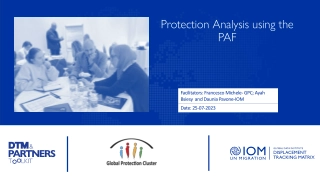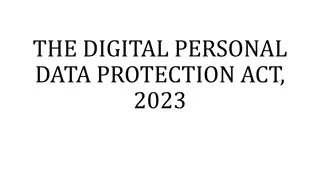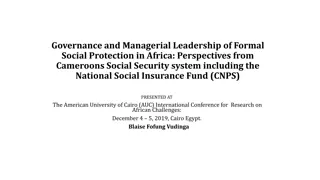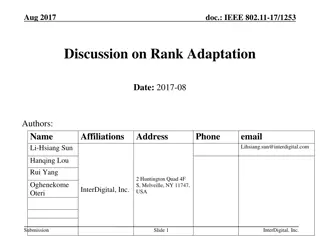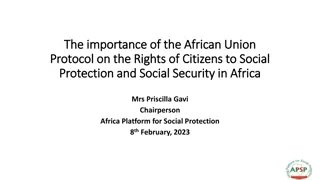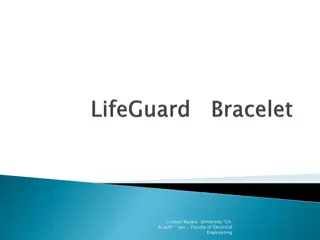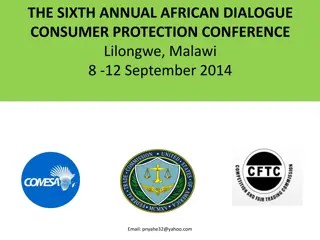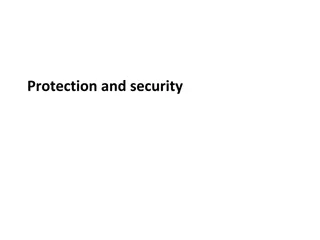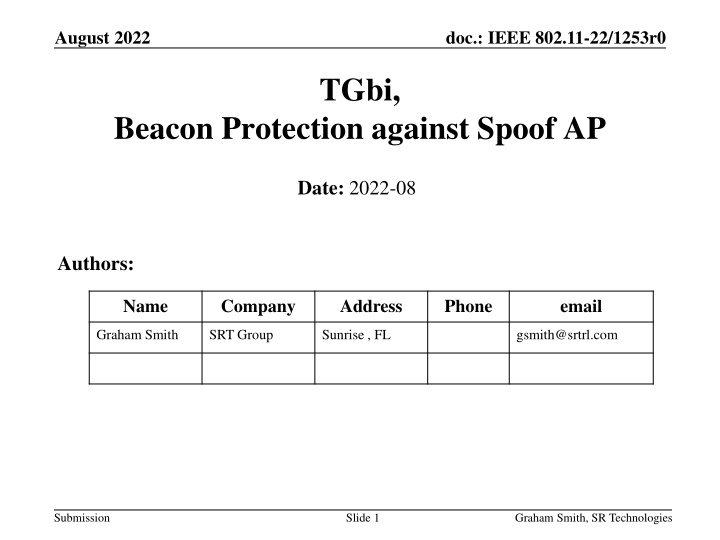
IEEE 802.11-22 Beacon Protection against Spoof AP in August 2022
Explore solutions to prevent spoofed Access Points from compromising network security in the IEEE 802.11-22 document from August 2022 by Graham Smith of SR Technologies. The presentation discusses the risks posed by malicious APs and suggests ideas such as location-based authentication and SSID profiling to enhance security measures.
Download Presentation

Please find below an Image/Link to download the presentation.
The content on the website is provided AS IS for your information and personal use only. It may not be sold, licensed, or shared on other websites without obtaining consent from the author. If you encounter any issues during the download, it is possible that the publisher has removed the file from their server.
You are allowed to download the files provided on this website for personal or commercial use, subject to the condition that they are used lawfully. All files are the property of their respective owners.
The content on the website is provided AS IS for your information and personal use only. It may not be sold, licensed, or shared on other websites without obtaining consent from the author.
E N D
Presentation Transcript
August 2022 doc.: IEEE 802.11-22/1253r0 TGbi, Beacon Protection against Spoof AP Date: 2022-08 Authors: Name Company Address Phone email Graham Smith SRT Group Sunrise , FL gsmith@srtrl.com Submission Slide 1 Graham Smith, SR Technologies
August 2022 doc.: IEEE 802.11-22/1253r0 The Problem Dastardly people set up APs that spoof the home BSS of the target X. The J Lo paparazzi attack If X s mobile, STA X, comes in range, it will attempt to Associate It does not matter what MAC Address STA X is using, the mere fact it sent an Association Request exposes that it (or someone from X s home) is in the area. TASK - Is it possible to know that the AP is the real deal BEFORE attempting to Associate? Still early days but looking for comments and feedback Submission Slide 2 Graham Smith, SR Technologies
August 2022 doc.: IEEE 802.11-22/1253r0 How to stop the STA from sending Association Request to a spoof? Protected Beacons Only works after Association Is this being considered in TGbi (Requirement 34)? Could this be considered in TGbh? Three basic IDEAS: 1. Location based 2. SSID Profile 3. Identifiable Beacon Submission Slide 3 Graham Smith, SR Technologies
August 2022 doc.: IEEE 802.11-22/1253r0 Location based Basically, knowing location of your favorite SSID(s). Maybe most applicable to Home network and/or office User sets this up GPS linked 1. Use the GPS to save the location when first setting up the scheme. STA/User prompted to save GPS co-ordinates of the BSS. 2. STA gets probe response or Beacon from spoof Home AP . 3. Before sending Association Request, STA check GPS co-ordinates If matches saved location, then send Request If does not match location, do not send Request. Advantage simple, seems to be very secure Disadvantage not 802.11 related, relies on higher layer application. Could be described in an informative way? Just leave it to someone to write the APP? Submission Slide 4 Graham Smith, SR Technologies
August 2022 doc.: IEEE 802.11-22/1253r0 SSID Profile a. STA saves a SSID list/profile of networks in vicinity of home and creates an SSID profile b. When spoof AP appears, STA checks other SSIDs in range and checks them against the stored profile c. STA can decide if the AP meets the SSID profile . For example: Any new or unexpected SSIDs, e.g., obvious new SSIDs such as Bedbug Hotel , would indicate not at home . Absence of expected SSIDs (plus presence of unexpected) would indicate take care . This could be 802.11 - User or maybe the BSS/AP instructs STA to carry out Neighbor Report , which is saved. STA performs Neighbor Report activity (does not send it) before sending Association Request. Submission Slide 5 Graham Smith, SR Technologies
August 2022 doc.: IEEE 802.11-22/1253r0 SSID Profile Pretty simple. An algorithm should be pretty simple to compare Neighbor Reports . Save Home SSID list, need to match say 3 and no more than 1 new Could the spoof somehow set up other spoofs to re- create the same SSID list? seems doubtful. Could be described as part of 802.11 in the Privacy section. Submission Slide 6 Graham Smith, SR Technologies
August 2022 doc.: IEEE 802.11-22/1253r0 Identifiable Beacon Present protected Beacon scheme seems to only work after association (BIGTK) Disclosure, by no means am I a crypto or PMF expert, so I might have this all wrong Identifiable Beacon Beacon Protection ID BASIC IDEA Inclusion of a Beacon Protection IE in Beacon frames STA first associates (User knows this is Home ) and receives a BPID (fixed key for that AP). BPPN Beacon protection packet number, incremented approx. every hour. AP includes a Beacon Protection IE with BPPN, Random number, and BPC (beacon protection check) BPPN is incremented every X beacons STA calculates BPC = function {BPPN, Random Number, BPID} AND notes BPPN value If BPCs match, AND BPPN value is OK , then Beacon is genuine Everytime BPPN changes, a new random number and hence a new MPC. Something like 1 hour updates may be good enough? Submission Slide 7 Graham Smith, SR Technologies
August 2022 doc.: IEEE 802.11-22/1253r0 Details Beacon Protection Packet Number BPPN A beacon is every 102400 us or 9.765625 per second Assume BPPN increments every 32768 beacons (2^15) Assume 16 bit BPPN, then rolls over every 2524 days (6.97 years) Beacon Protection ID BPID Assume 64 bits Assume 10 Thash/sec (is that too high?) then >5 years Is it worth the effort? What s a good function? BPC = function {BPPN (16 bit), seed (48 bit?), BPID (64 bit)} Submission Slide 8 Graham Smith, SR Technologies
August 2022 doc.: IEEE 802.11-22/1253r0 Basic , AP includes a BP IE in its beacons which changes periodically IE includes BPPN, a Random number, and BPC. STA checks the BPPN and the BIC and matches to the Key (BPID) that the known good AP provided. BPC = function {BPPN, Random number, BPID} STA checks that BPPN makes sense, i.e., is advanced from last time at home. Possible attacks Attack Spoof records a series of Beacons with BP IEs and replays this at the spoof AP. Counter - STA can check time and estimate the BPPN to confirm BPPN is correct. BPPN 16 bits, repeats every 6.9 years - updates every hour Attack - Beacons can be recorded, and Key found by brute strength. How long to do this? Counter - Add a mechanism to change the BPIDK regularly (each week, each month, each year?) Needs to cater for multiple home STAs Submission Slide 9 Graham Smith, SR Technologies
August 2022 doc.: IEEE 802.11-22/1253r0 Changing BPID BPID is provided post Association. Hence, not having the latest is not a problem for association, but it could see the home AP as a spoof. BPID can be provided together with TTL (time to live) STA knows if it is out-of-date and takes a chance? AP could provide the next BPID in advance with TTS (time to start) and TTL. Doubles the validity time BUT With BPID 64 bits and BPPN 16 bit and Seed 48 bit Then make TTS/ TTL 1 year? OR not change it at all? Beacon is showing a solution every hour, how does that lessen the time to brute strength it? Submission Slide 10 Graham Smith, SR Technologies
August 2022 doc.: IEEE 802.11-22/1253r0 Conclusion The Beacon Protection ID seems to work. It solves the spoof AP problem With BPC changing, say, every hour, not too much work for the AP STA can check the BP IE in the beacon to confirm authenticity of the AP/BSS Need to determine optimal lengths of BPPN, BPID and Seed Need to determine best function . Submission Slide 11 Graham Smith, SR Technologies
August 2022 doc.: IEEE 802.11-22/1253r0 Submission Slide 12 Graham Smith, SR Technologies
August 2022 doc.: IEEE 802.11-22/1253r0 Straw Poll Do you support the Beacon Protection ID scheme as outlined in <this presentation> for inclusion in the TGbi Draft? Y/N/A Submission Slide 13 Graham Smith, SR Technologies

